On March 9, 1966, members of the Irish Republican Army (IRA) blew up Nelson’s Pillar, a 40.8m monument erected in 1808 in downtown Dublin as a tribute to Horatio Nelson, a British naval officer and strategist. The gesture served as a reminder that many in Ireland were hell-bent on kicking the colonials out.
“Statues have a habit of exploding in Dublin,” says Donal Fallon, a guide who led me and nine others on a two-hour tour earlier this month.
Fallon works for Historical Walking Tours of Dublin, one of many companies offering tours of the city’s historic downtown. Sexual history, women’s history and “Viking and medieval Dublin” are among the specialized tours offered in addition to general tours, all “conducted by history graduates of Trinity College Dublin and University College Dublin,” according to the company’s Web site. Fallon, whose specialty is social history, presented an engaging tour that was heavy on monuments and statues, many located within a half-hour’s walking distance of Trinity College Dublin, where the tour began.
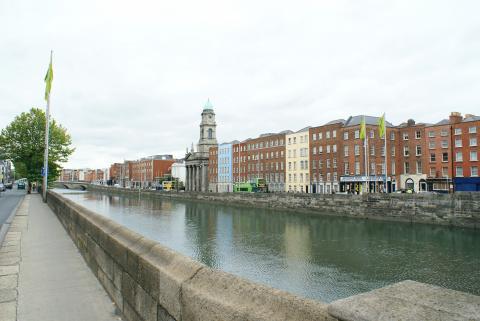
Photo: Noah Buchan, Taipei Times
And he proved to be quite the raconteur. A statue of Irish political leader Daniel O’Connell, for example, liberated a number of historical anecdotes about Ireland’s struggle for independence from the British.
Fallon covered O’Connell’s anti-British radicalism (his campaign against the Act of Union), conflict with the Guinness brewery (O’Connell was the scion of a rival brewer), and his friendship with Frederick Douglass, an emancipated slave from the US who toured and lectured in Ireland.
A few paces up O’Connell Street brought the tour to the General Post Office, which for Fallon served as an opening to discuss the 1916 Easter Rising, an insurrection against British rule that lasted less than a week. Though it failed to unite the Irish, the memory of its heroes symbolically remains in bullet holes visible on the building’s facade.
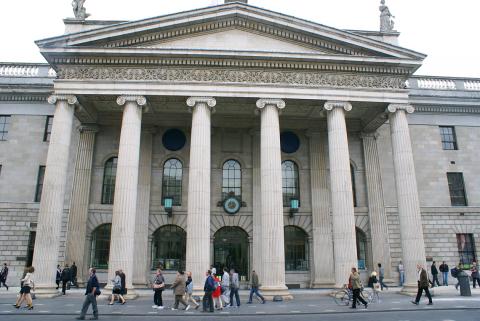
Photo: Noah Buchan, Taipei Times
Many of the struggles, rebellions and insurrections Fallon discusses date back to 1800 and the Act of Union. And what is that, Fallon asks us outside the Old Parliament Building?
“It’s the only time parliamentarians have ever voted themselves out of a job,” he says, adding that the Irish aristocracy and politicians sold their voting rights to the British crown. The building was shuttered following the vote until 1803 when it was sold to the Bank of Ireland (with the proviso that it never reverts to a parliament).
Back on O’Connell Street, we stand below the Monument of Light, a phallic, needle-like structure erected in 2003 where Nelson’s Pillar once stood. Discussing Ireland’s complicated past, Fallon says many in Dublin now defend the pillar because it was cast by Irish tradesmen and offered a viewing platform for the city. The new monument pricks the aesthetic sensibility of Dubliners, is historically meaningless and serves no practical function, he says.
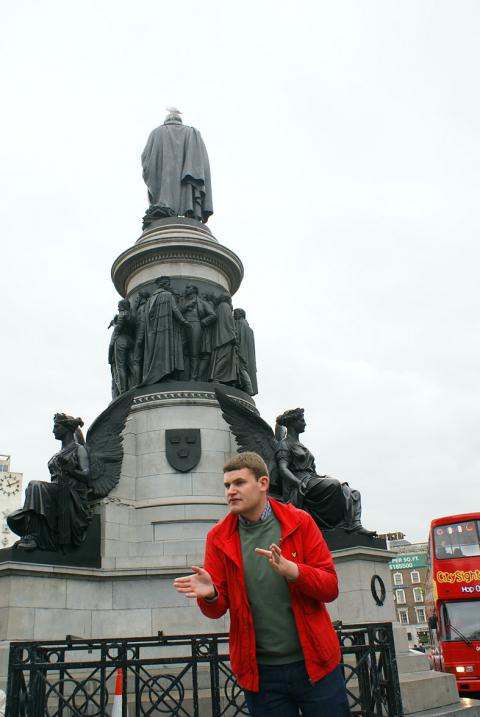
Photo: Noah Buchan, Taipei Times
“Jesus, can’t we just have the old one back?” Fallon asks.
Tickets for Historical Walking Tours of Dublin are 12 euros (US$16). For more information and online bookings, visit www.historicalinsights.ie.
Dublin Literary Pub Crawl
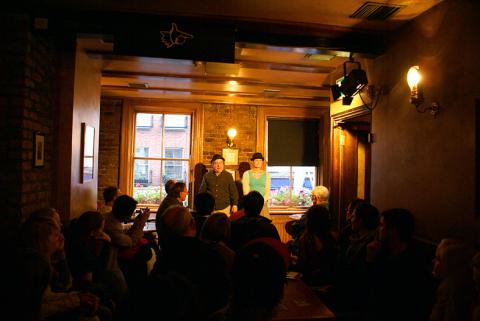
Photo: Noah Buchan, Taipei Times
Dublin’s downtown contains as many pubs as it does statues and monuments. Many of these watering holes have become famous due to the lettered denizens who frequented them between bouts of literary genius. The atmosphere can be summed up with a quote, often heard on Dublin’s streets, by author Brendan Behan: “I am a drinker with a writing problem.” On his death at the age of 41, Daily Express reporter Rene MacColl opined that he was “too young to die, but too drunk to live.”
The Dublin Literary Pub Crawl celebrates this seedier side of Ireland’s literary history with over two hours of street theater, literary quotation and all-around boozing. My tour was led by two professional actors who, between a pint at the Duke and a tipple at the Temple, performed skits and made references to the works of James Joyce, Oscar Wilde and the famously inebriated Behan. Anyone interested in a rich and varied account of Dublin’s literary history should set aside a few hours to participate in this tour, which ends with a quiz and prizes.
Tickets are 12 euros (US$16). For more information and online bookings, visit www.dublinpubcrawl.com.
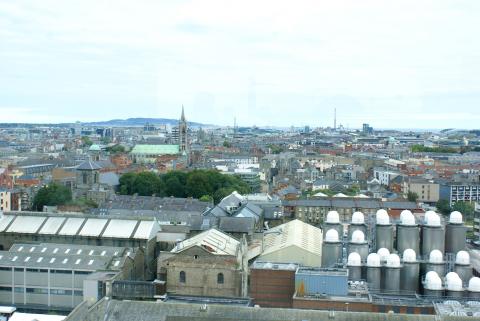
Photo: Noah Buchan, Taipei Times
Guinness Storehouse
If it’s just a pint you’re after, you can cut out the middleman and pour your own at the iconic Guinness Storehouse. Located in the bowels of a disused fermentation plant, it was designed to resemble a giant glass that would be capable of holding 14.3 million pints — presumably enough to satiate the thirst of someone as fond of drinking as Behan.
The exhibits aren’t particularly noteworthy — installations and images of barley and hops covering several floors, with a little history thrown in for good measure — but the souvenir shop is loaded with all manner of Guinness merchandise.
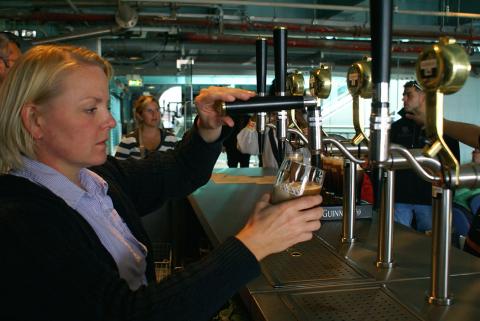
Photo: Noah Buchan, Taipei Times
But to be honest, we came for the pints, not the displays or memorabilia. Highlights include “pour your own pint” on the fourth floor — “perfect pourers” receive a certificate of achievement — and the Gravity Bar, a circular glass enclosure built on the roof with a 360-degree view of Dublin.
Tickets are 14.40 euros (US$19) and include one pint of Guinness. For more information and online bookings, visit www.guinness-storehouse.com.
Kilmainham Gaol

Photo: Noah Buchan, Taipei Times
Don’t drink too much, though, because around the corner from the brewery is Kilmainham Gaol, one of the largest unoccupied prisons in Europe. Erected in 1796, it was home to many rebels from the 1916 Easter Rising. Today it stands as a symbol of Ireland’s long struggle for independence.
Closed in 1924, it has rbeen featured in historical biopics such as In the Name of the Father and Michael Collins.
Tickets are 6 euros (US$8). For more information, visit www.heritageireland.ie/en/dublin/kilmainhamgaol.
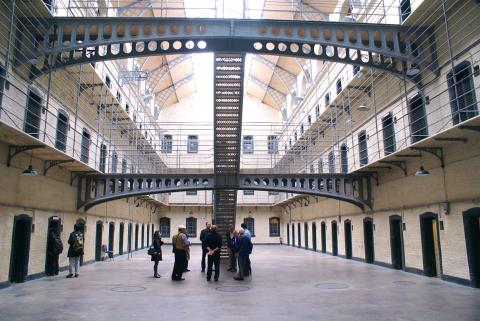
Photo: Noah Buchan, Taipei Times
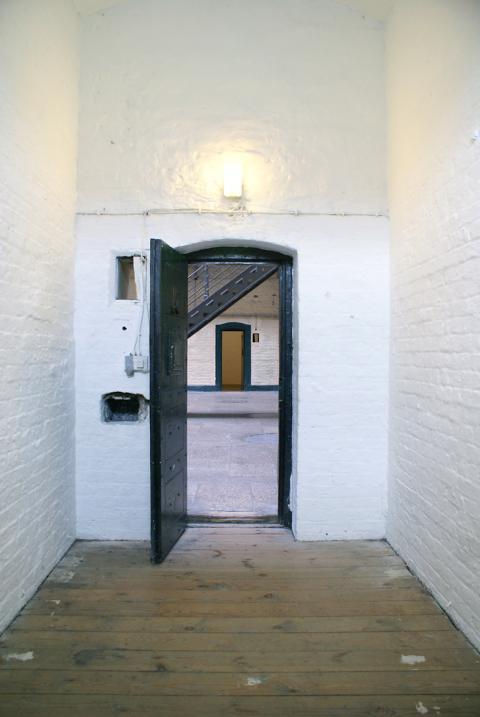
Photo: Noah Buchan, Taipei Times

Behind a car repair business on a nondescript Thai street are the cherished pets of a rising TikTok animal influencer: two lions and a 200-kilogram lion-tiger hybrid called “Big George.” Lion ownership is legal in Thailand, and Tharnuwarht Plengkemratch is an enthusiastic advocate, posting updates on his feline companions to nearly three million followers. “They’re playful and affectionate, just like dogs or cats,” he said from inside their cage complex at his home in the northern city of Chiang Mai. Thailand’s captive lion population has exploded in recent years, with nearly 500 registered in zoos, breeding farms, petting cafes and homes. Experts warn the

The unexpected collapse of the recall campaigns is being viewed through many lenses, most of them skewed and self-absorbed. The international media unsurprisingly focuses on what they perceive as the message that Taiwanese voters were sending in the failure of the mass recall, especially to China, the US and to friendly Western nations. This made some sense prior to early last month. One of the main arguments used by recall campaigners for recalling Chinese Nationalist Party (KMT) lawmakers was that they were too pro-China, and by extension not to be trusted with defending the nation. Also by extension, that argument could be
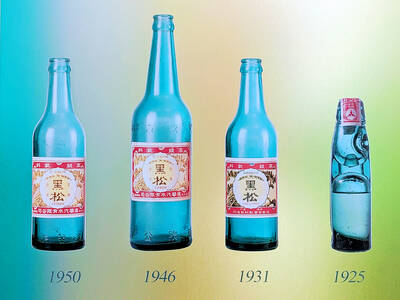
Aug. 4 to Aug. 10 When Coca-Cola finally pushed its way into Taiwan’s market in 1968, it allegedly vowed to wipe out its major domestic rival Hey Song within five years. But Hey Song, which began as a manual operation in a family cow shed in 1925, had proven its resilience, surviving numerous setbacks — including the loss of autonomy and nearly all its assets due to the Japanese colonial government’s wartime economic policy. By the 1960s, Hey Song had risen to the top of Taiwan’s beverage industry. This success was driven not only by president Chang Wen-chi’s
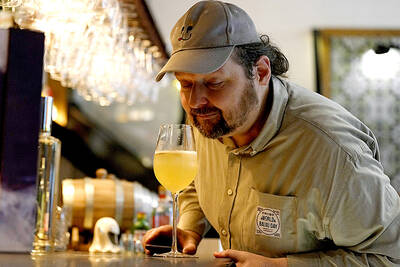
The centuries-old fiery Chinese spirit baijiu (白酒), long associated with business dinners, is being reshaped to appeal to younger generations as its makers adapt to changing times. Mostly distilled from sorghum, the clear but pungent liquor contains as much as 60 percent alcohol. It’s the usual choice for toasts of gan bei (乾杯), the Chinese expression for bottoms up, and raucous drinking games. “If you like to drink spirits and you’ve never had baijiu, it’s kind of like eating noodles but you’ve never had spaghetti,” said Jim Boyce, a Canadian writer and wine expert who founded World Baijiu Day a decade